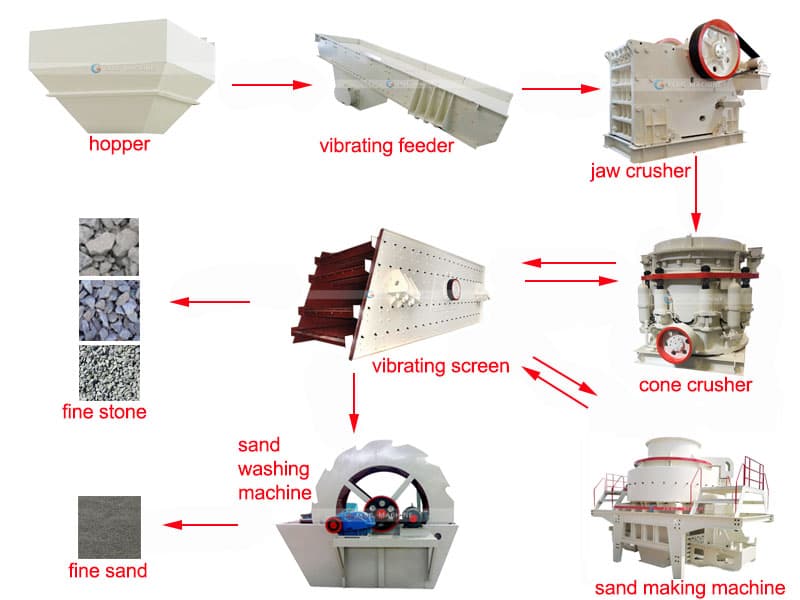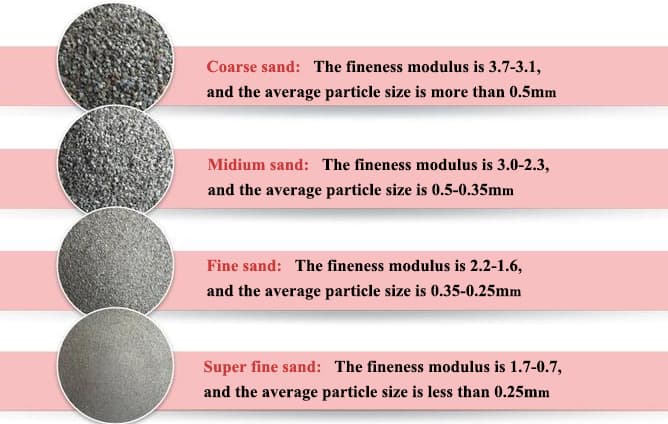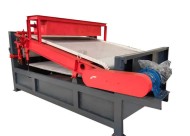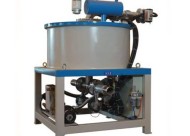With the increasing number of construction projects in my country, the amount of concrete is increasing, and the demand for sand is also increasing. High-quality machine-made sand can meet the needs of different construction projects.
So how to produce high-quality machine-made sand? It needs to start from the following six aspects: material selection, equipment, technology, quality control, etc.
1. Do a good job in the selection of base materials
The parent rock used for processing machine-made sand shall not have potential alkali-aggregate reactivity, and its compressive strength shall not be less than 80MPa. Before the material selection, the rock parent material should be sampled and tested. The compressive strength, lithology, sulfide and sulfate content of the rock must meet the requirements to ensure that the quality of the parent material is qualified.
There are many raw materials that can be used as machine-made sand, generally granite, basalt, river pebbles, cobblestone, limestone, calcite, andesite, rhyolite, diorite, diabase, sandstone, tailings, slag, quartz stone, etc. The artificial sand made of different rocks has differences in strength and particle size, and the corresponding uses will also be different.
The following is a general description of the uses of several ore sand making:
(1)Sandstone: The quartz content is high, and it is widely used in the sandstone production line. The problem of stone powder must be solved in production.
(2)Quartz sandstone: Quartz sandstone is a high-quality raw material for sand making, which can reach or even surpass natural sand in terms of strength and grain shape.
(3)River pebble: River pebble is also a good quality raw material for sand making. It is the best choice to replace natural sand in terms of strength, grain shape and chroma.
(4)Limestone: In the sand and gravel production line, it can be used as the raw material of sand and stone at the same time, and the stone powder can also be reused.
(5)Basalt: Sand made of basalt mixed in concrete can reduce the weight of the concrete, but it is still very strong, and has the characteristics of sound insulation and heat insulation. It is a good aggregate for lightweight concrete in high-rise buildings.
(6)Granite: Granite with high quartz content and low sulfide content is a good quality raw material for sand making, but the problem of powder must be solved.
The mud blocks in the machine-made sand are mainly mud entrained by the boulders that produce the sand. When mining the mine, the surface vegetation and mud should be removed to prevent the sundries such as weathered sand and mud from being mixed into it. During the feeding process, the block stone should be further screened by the vibrating feeder to remove the soil, and the screened soil and small pieces of gravel should be treated as waste, and cannot be mixed into the sand for use.
The leftovers after the production of crushed stone are processed into machine-made sand or stone powder and stones, which can effectively supply the sand and gravel aggregate market and form a circular industrial chain. It not only achieved good economic benefits, but also effectively solved the problems of waste water pollution and resource waste.
2. Machine-made sand production equipment and process
Process flow of machine-made sand production: The basic production process can generally be divided into the following stages: ore lumps → coarse crushing → medium crushing (partially set screening) → fine crushing → screening → dust removal → machine-made sand.
The common crushing process and equipment combination produced are:
- Jaw Crusher + Impact Crusher;
- Jaw Crusher + Cone Crusher;
- Jaw Crusher + Roll Crusher;
- Jaw crusher + impact crusher + impact sand making and shaping machine;
- Jaw crusher + Cone crusher + Impact sand making and shaping machine or sand making system.
High-quality machine-made sand production process:
- According to the separation method of stone powder, it can be divided into “wet sand making”, “dry sand making” and “semi-dry sand making”;
- According to the technological process, it can be divided into “separate sand making” and “joint sand making”;
- According to the structural form, it can be divided into “planar sand making” and “floor sand making”.
At present, there are three main production methods of stone powder separation: dry method, wet method and semi-dry method. Dry production adopts wind separation of stone powder, and through wind separation technology, particle size adjustment and stone powder screening are realized;
In wet production, sand washing machine is used to wash stone powder. The equipment mainly includes wheel and spiral sand washing machine. Because the loss of fine-grained sand and stone powder is less, the produced machine-made sand is relatively well-graded.
3. Particle gradation (fineness modulus) control
At present, the general requirement for the fineness modulus of manufactured sand is zone 2 (medium sand). Through practice, the screen aperture of dry-processed sand can be easily controlled below 5mm, and the screen aperture of water-washed machine-made sand can be easily controlled below 3.2mm. However, the aperture of the water-washed machine-made sand screen is controlled at 4mm, which can greatly increase the output, but the fineness modulus reaches zone 3 (coarse sand), which can be mixed with natural zone 1 (fine sand) to reach zone 2 (medium sand).
The shape of the machine-made sand is mainly affected by factors such as the development of lithological joints in the parent rock, the type of crushing equipment and the type of screen. The lithology of the parent rock affects the rock crushing surface and degree of crushing. The square-hole screen has better control of particle shape.
4. Stone powder content control
In the production process of machine-made sand, a small amount of stone powder with particles less than 0.075mm is inevitably attached. According to the quality standard of natural sand, particles smaller than 0.075mm are defined as mud, and the content limit of mud is very strict. The stone powder in machine-made sand is obviously different from mud. A large number of experimental studies and engineering application practice show that a certain amount of stone powder in machine-made sand is of great help in improving the working performance of low- and medium-strength concrete, and has little effect on the strength of concrete. However, when the content of stone powder is high, it has an adverse effect on the preparation of high-strength concrete. So how to remove and control the excess stone powder in the machine-made sand is one of the key technologies in the production of machine-made sand.
The smaller the fineness modulus of machine-made sand, the finer the particles as a whole, and the more stone powder content. It is not advisable to simply increase the stone powder content to reduce the fineness modulus in production. Since these two technical indicators are in conflict with each other, it is necessary to seek an interval where both meet the requirements of the specification.
The crushing index of manufactured sand is used to measure the ability of manufactured sand to resist crushing under gradually increasing loads to evaluate its applicability in engineering, and is an important indicator to indirectly express the firmness of manufactured sand. The crushing index directly affects the strength of the prepared concrete, especially for high-strength concrete.
5. Crushing index control
The crushing index value of machine-made sand with better particle shape is generally in the range of 20% to 25%. The content of needle flakes in machine-made sand is most sensitive to the crushing index value. The crushing index value of machine-made sand is generally above 30%, or even higher. For mixing ordinary concrete, machine-made sand with crushing index value below 30% should be used. The production control measures are mainly to select the rock with high compressive strength of parent rock and good rock mass integrity to make sand.
6. Segregation phenomenon control measures
The practice has proved that the segregation phenomenon of manufactured sand is serious, resulting in large differences in gradation and fineness modulus indexes before and after entering the site. For example, this phenomenon exists in some construction sections of the Zhengwan Railway. The fineness of the inspection in the production link of the mining area meets the requirements, but the random inspection of the warehouse often fails.
The finished machine-made sand should be stacked reasonably, and the escalating inclined stacking method should be adopted to prevent the small particle size from slipping and accumulating. Choose a relatively flat public transportation road, try to level the construction access road into the concrete station area, properly control the speed of the vehicle, and reduce the segregation of machine-made sand caused by the bumping of the vehicle. During the unloading process, try to elevate the box to facilitate the rapid sliding of the material and reduce the accumulation of coarse particles of the material to the outside.
The machine-made sand production line is special equipment for producing construction sand and stone. The sand has uniform particle size and high compressive strength, which is more in line with the requirements of high-standard construction sand than natural sand. High degree of automation, low operating cost, high crushing rate, energy saving, large output, less pollution, and easy maintenance.
LATEST PRODUCTS
Heavy Plate Feeder
Capacity: 100-240 m3/h Power: 15-45 kW Speed: 0…
Plate Magnetic Separator
【Capacity】8-35 t/h 【Power】1.5-3 kW 【Applic…
Slurry Magnetic Separator
【Capacity】10-100 m3/h 【Feeding Material Densi…













